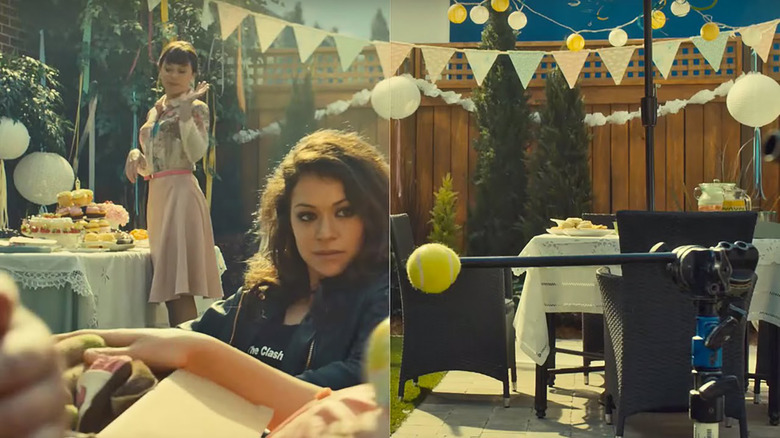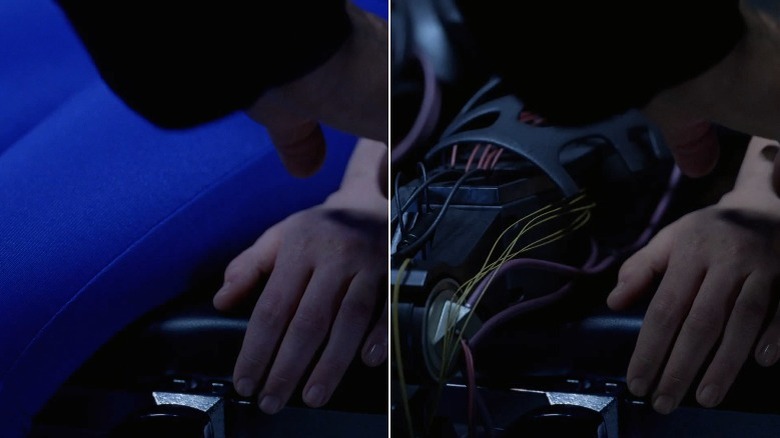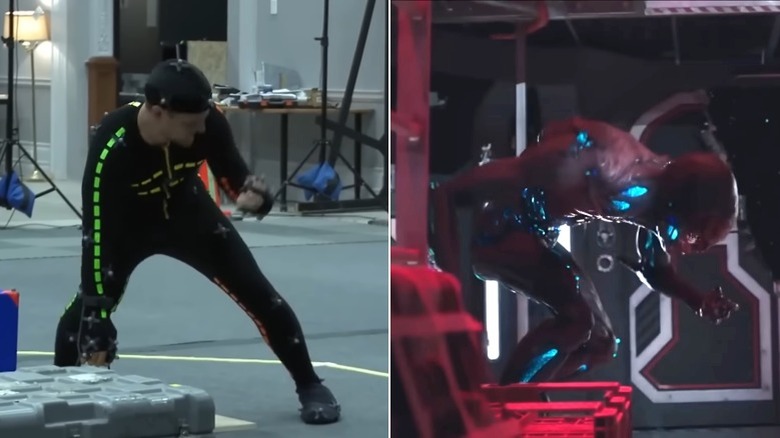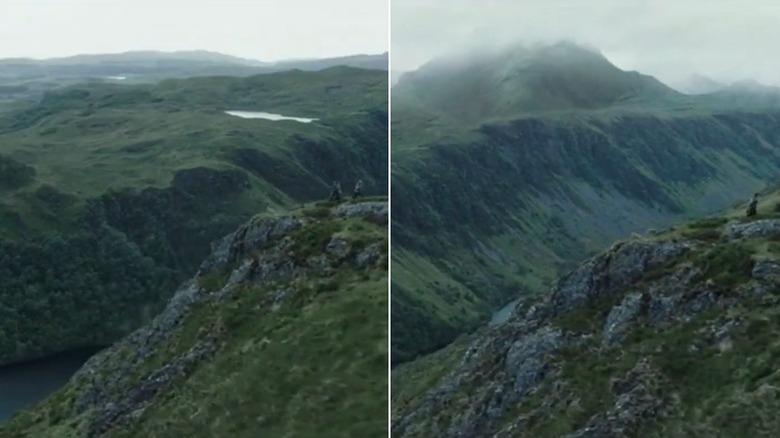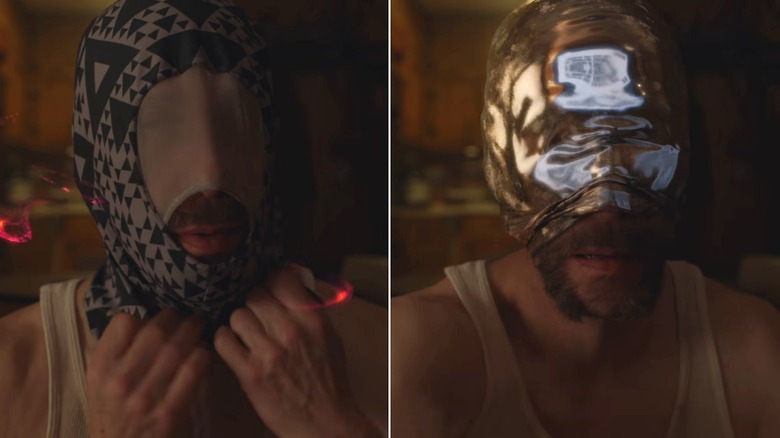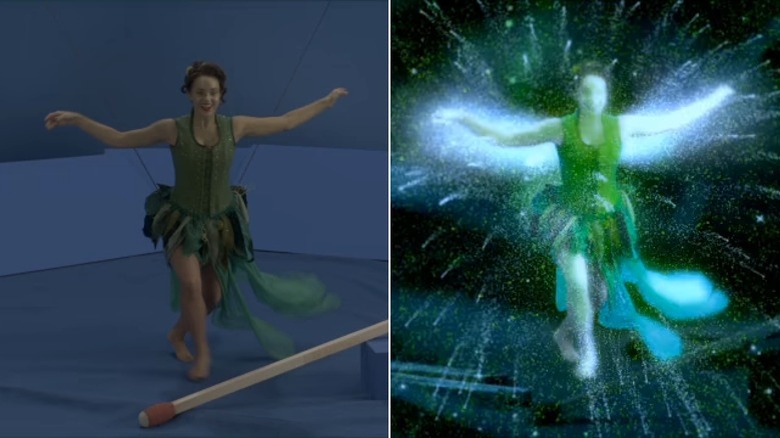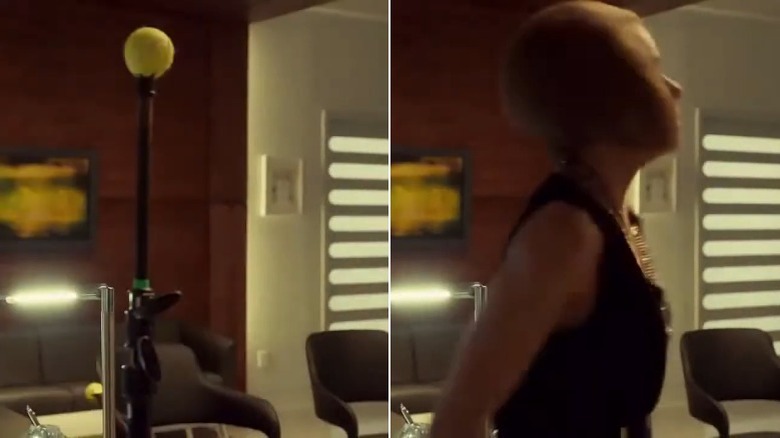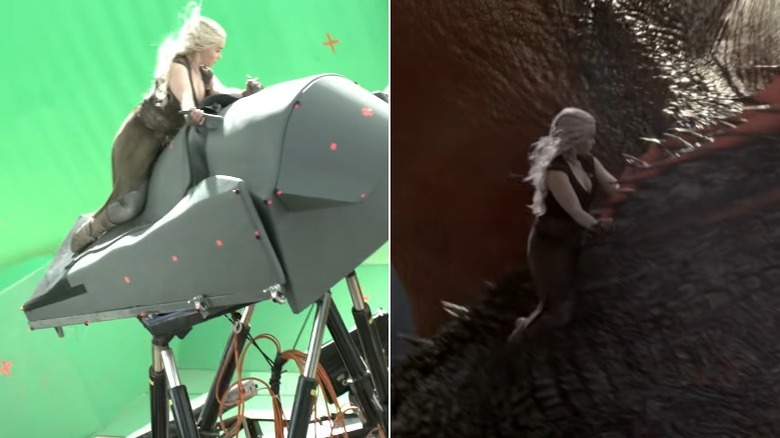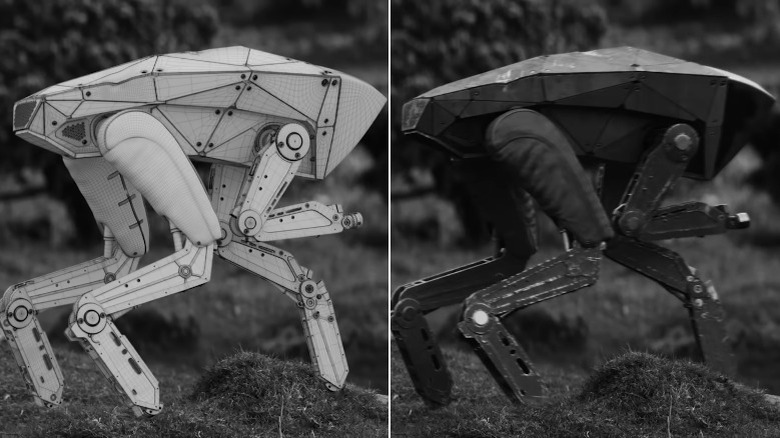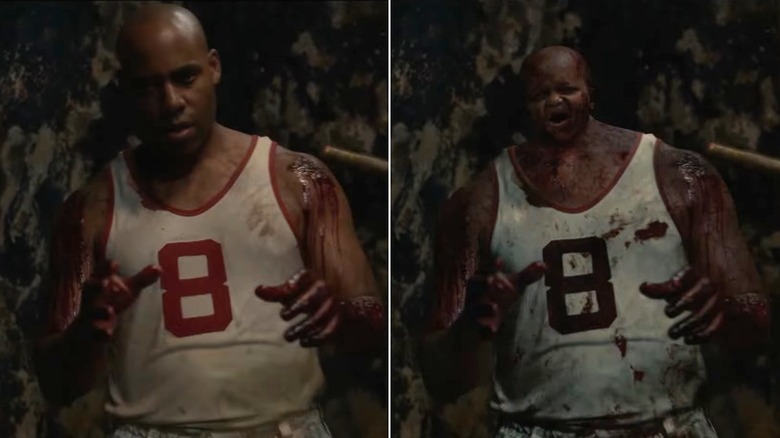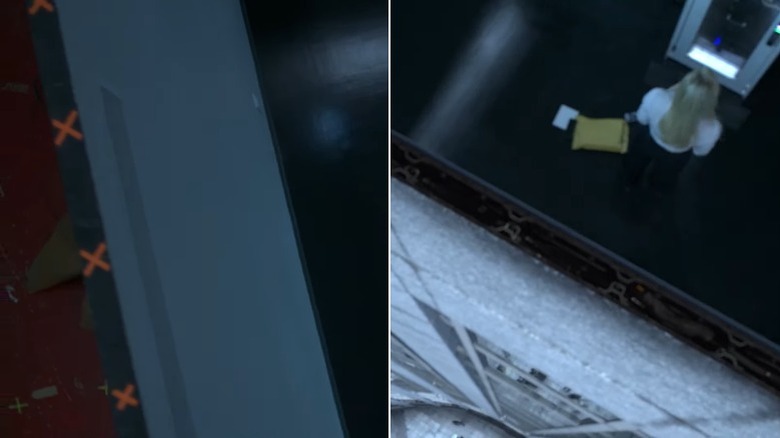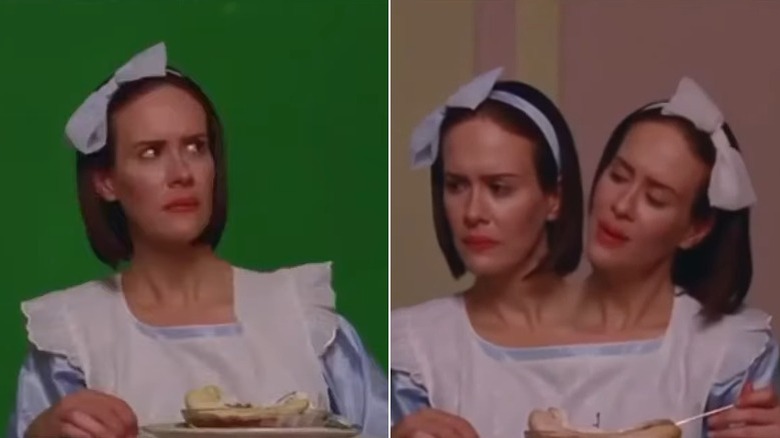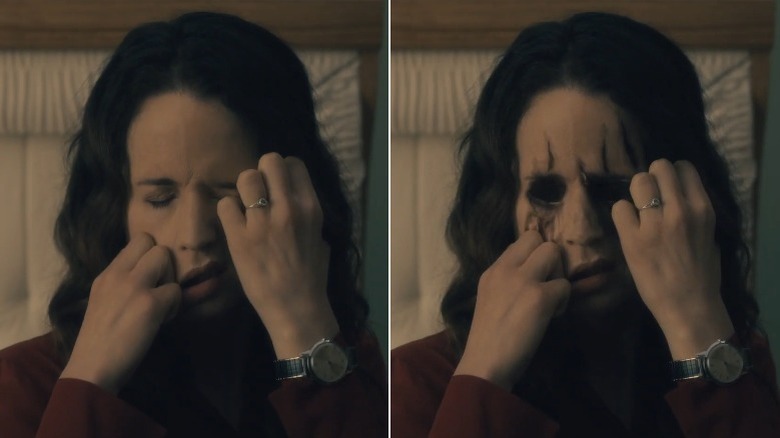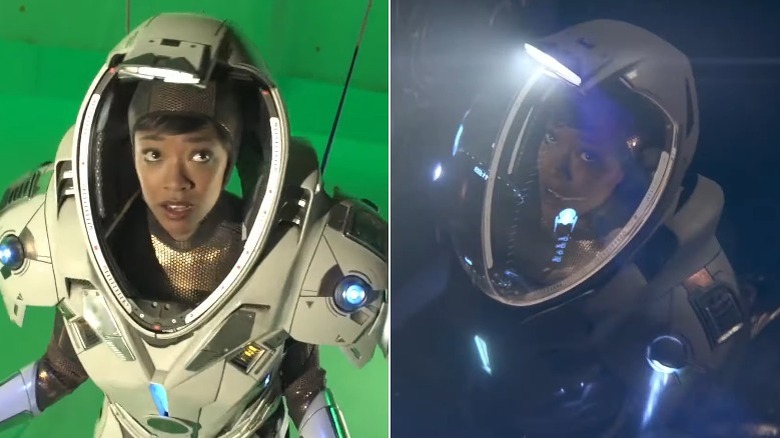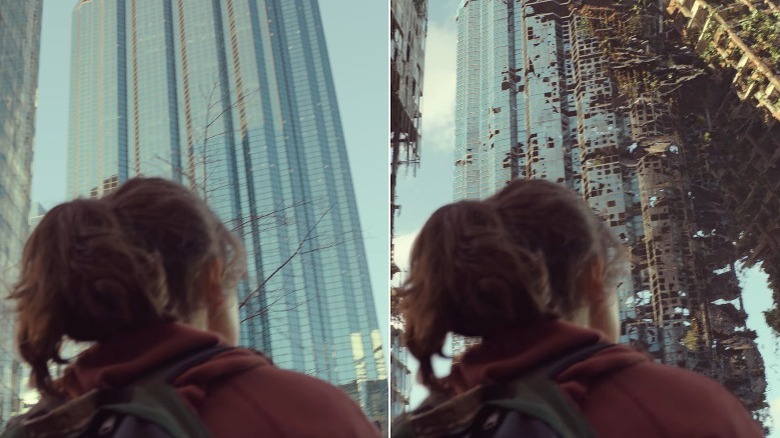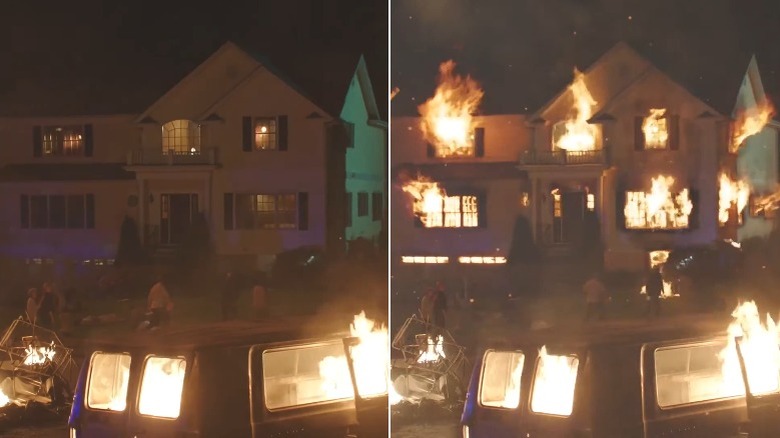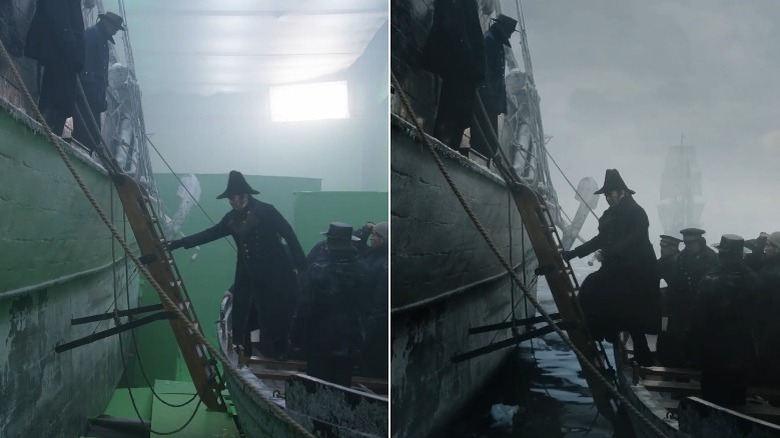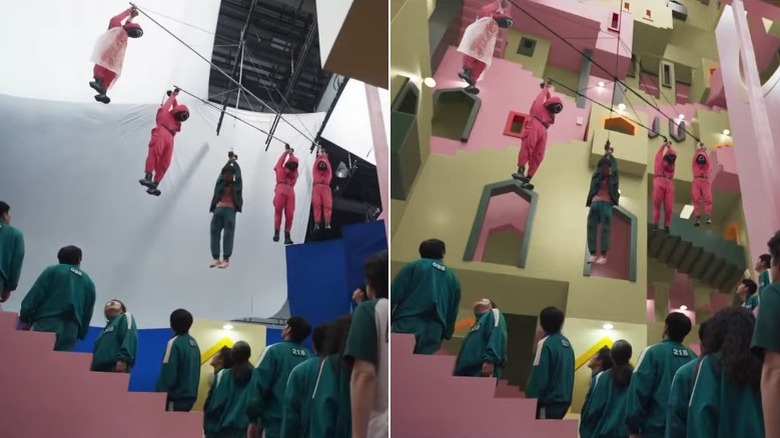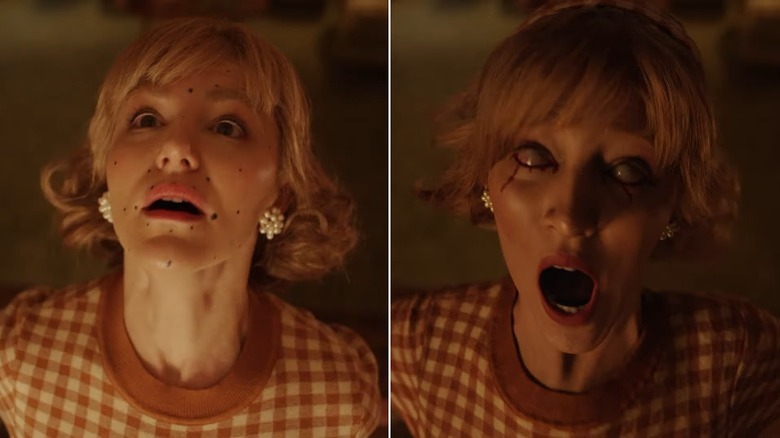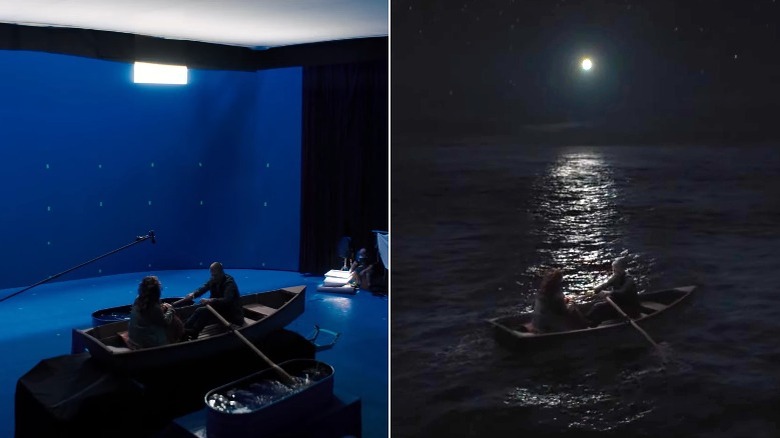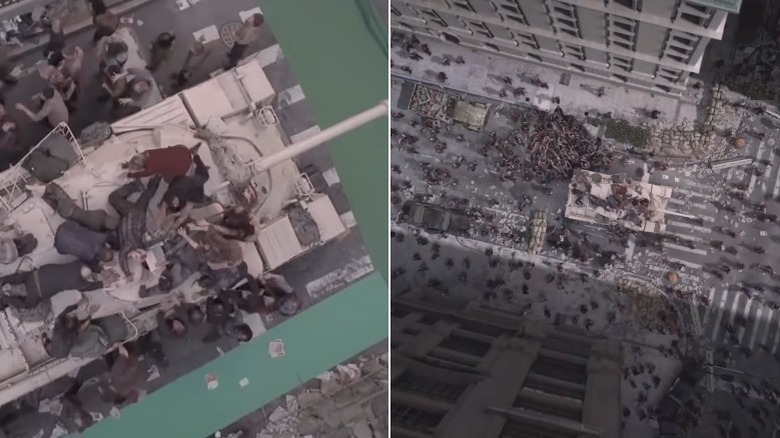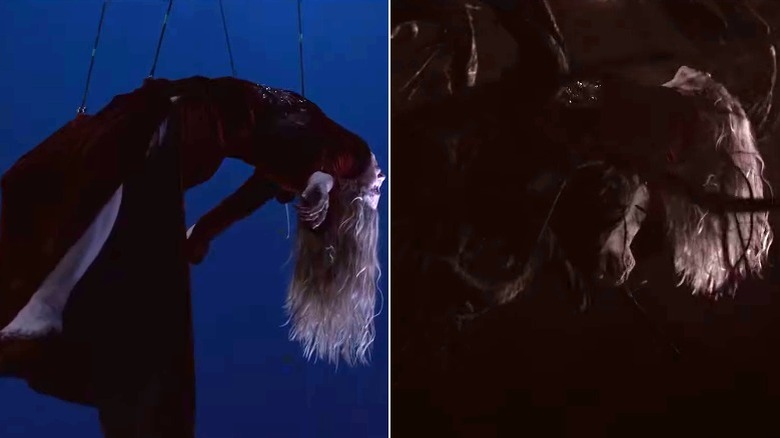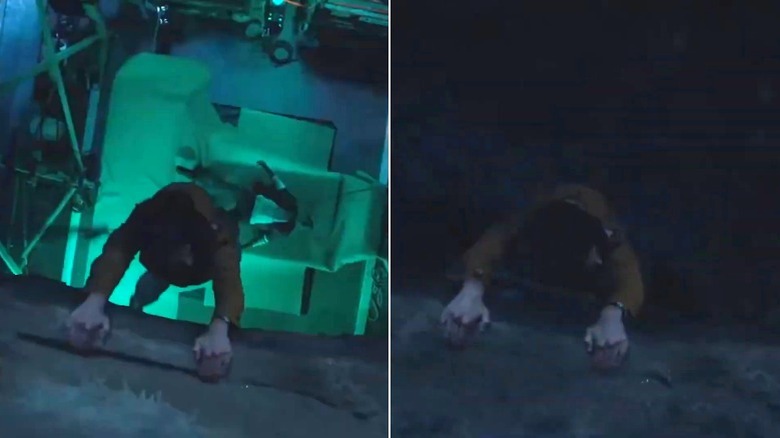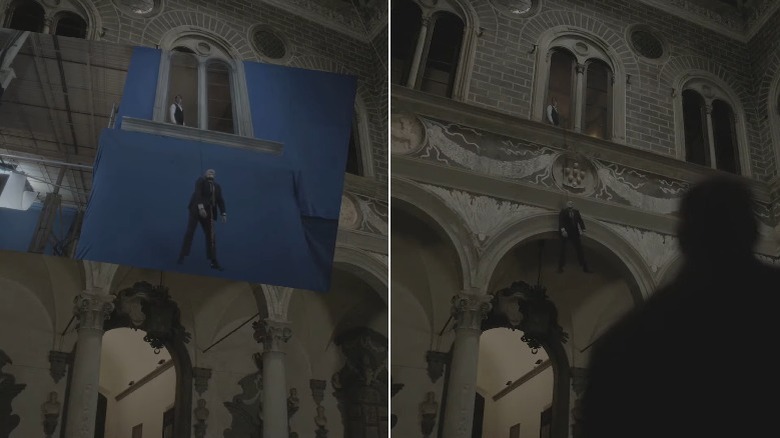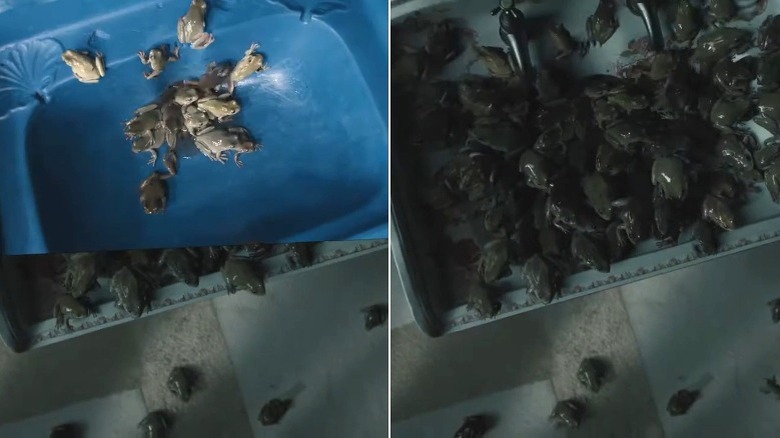What Great Shows Look Like Before Special And Visual Effects
We don't always talk enough about visual effects when we talk about the components that make up a great film or television series. Quality writing, acting, cinematography, and production design are essential and mutually complementary, of course. But the realm of VFX is equally crucial in the way that it simultaneously informs and is informed by those other disciplines, often constituting the key ingredient that allows a scene or a shot to accomplish its goal — whether that goal is steeped in authenticity, scariness, wonder, tension, or surrealism.
In that sense, comparing the before and after of shots featuring computer generated imagery (CGI) and effects can be highly instructional. Thanks to the showcase reels released by many VFX studios and behind-the-scenes featurettes, it's possible to get a side-by-side glimpse at what several great TV shows look like prior to the addition of digital effects. The comparisons are sometimes amusing, sometimes revelatory, sometimes unbelievable, and always a testament to what resourceful, inventive, and indispensable professionals VFX artists are. Here are some great examples of what some of your favorite TV shows like "Game of Thrones," "Orphan Black," "Westworld," "The Boys," and more looked like before VFX.
Westworld put the host actors in chroma suits
Arguably the most lavish sci-fi production in HBO history, "Westworld" spared no expense when it came to bringing its sprawling world of android-filled theme parks to life. One of the most exciting parts of the show were the peeks behind the curtain we got from time to time, showing the hosts — i.e. the parks' android functionaries — in their bare, unvarnished form, being tinkered with by programmers. To create the stunning visual effect present in those scenes, in which the hosts' faux flesh-and-blood frames were stripped down to see-through mechanical skeletons, the actors were put in chroma suits, or blue screen suits.
A VFX reel by Important Looking Pirates, which worked on several episodes of the show across its first three seasons, reveals that a particular scene of Bernard (Jeffrey Wright) interacting with Dolores (Evan Rachel Wood) in the lab was accomplished by dressing Wood in a full-body blue suit. The character's robotic components were then created and overlaid on the chroma suit with CGI.
Proto hybrids in The Expanse were animated with motion capture
The interplanetary conspiracy plot of SyFy and Prime Video's "The Expanse" was given a frightful charge towards the end of Season 2 by the introduction of the protomolecular creatures known as "hybrids." Created by kidnapping children and infecting them with protomolecules, the hybrids were the most terrifying outgrowth of Project Caliban's effort to bend the discovery of the protomolecule to political and economic human interests.
Although they were originally children, the creatures — some standing as tall as 9 ft — were decidedly not childlike in appearance. In fact, to bring them to life, the show had adult performers create their movements while wearing motion capture suits, as revealed in a Spin VFX reel. Those movements were then translated into the hybrids' grotesque physical presence and nightmarish body language via CGI animation. Watching the show, you'd never guess that those moves came from an actual human being — which goes to showing how enormously talented and deeply under-appreciated motion capture performers are.
Andor combined location shooting with digital enhancement
Many thought it impossible, but Disney+'s "Andor" did it: Somehow, the Tony Gilroy-created, Diego Luna-starring series managed to give the world a modern-day piece of "Star Wars" media that pretty much everybody seemed to appreciate. Among the many reasons why the series managed to impress critics, fans, and casual viewers across the board was its sheer sense of grit, texture, and tangibility. More than almost every other "Star Wars" live-action work in the Disney era, its world felt real, with believable stakes.
To that end, the location shooting employed by the directorial team helped out immensely. For scenes set in the grassy mountain planet of Aldhani, the cast and crew took to Glen Tilt Park, located in Perthshire, in the southern area of the Scottish Highlands. The park's own mountainous terrain and moody taiga vegetation did most of the work in creating the ambience. But they were also given an extra digital oomph, with several more peaks added in for good measure, as showcased by Scanline VFX in a reel. Sometimes, great CGI is all about discretion.
Tim Blake Nelson wore a black-and-white motion tracking mask to play Looking Glass on Watchmen
HBO's wildly imaginative and unorthodox "Watchmen" series, at once a sequel and a reimagining of the original Alan Moore and Dave Gibbons comics, had a tough act to follow when it came to masks. The ever-shifting inkblot mask worn by Rorschach in the comics is, after all, among the most iconic superhero visuals of all time. Given that Rorschach himself is absent from the show, with the mask appearing only over the faces of the white supremacist Seventh Kalvary cult members inspired by his writings, expectations for an equally striking new vizard seemed even harder to meet. But they were met, and then some, thanks to Looking Glass.
The costumed alias of Tulsa police officer Wade Tillman (Tim Blake Nelson), Looking Glass wore a reflective mask that covered his entire head, making him look, by turns, like a walking mirror and a smudge of empty space. The vast majority of the mask's appearances were achieved with CGI. Although there was a real-life silver lamé mask available on set, it was used sparingly because Nelson couldn't see through it (via Polygon). Plus, a MARZ VFX reel reveals that, for one particular shot in which Tillman rolls up the mask, Nelson wore a black-and-white balaclava with a special motion tracking pattern and transparent mesh over his eyes. The mask and some of the character's face were then animated digitally in post-production.
It took several steps to bring Walter's LSD trip to life on Fringe
Despite the density of its sci-fi mythology, Fox's "Fringe" wasn't a show that resorted to striking, in-your-face visual effects all that often. One of the times in which it did was on the Season 5 episode "Black Blotter," which threw the show's established visual language into unexpected disarray while showing Walter Bishop (John Noble) suffering hallucinations from the titular form of LSD. Among his drug-fueled visions, Walter interacts with a green fairy (Allie Bertram), sees Carla Warren (Jenni Blong), and even imagines himself as a character in a Terry Gilliam-esque comedic animation.
For the sequences involving the fairy, a VFX reel reveals that several steps were involved in bringing the character to life and nailing her hallucinatory feel. Actress Allie Bertram was filmed separately in a blue chroma set, then overlaid at proper scale on Walter's scenes. Wings, sprinkles of fairy dust, specks of light, and a bluish glow were then added digitally to the composition. The rudimentary nature of the effect was very much intentional, as the lack of visual integration between the fairy and her surroundings was part and parcel with the character's existence as a bizarre figment of Walter's imagination.
Orphan Black used tennis balls for some clone interactions
A lot of the unique magic that made BBC America's "Orphan Black" an overachieving cult favorite among sci-fi buffs came from the coexistence of the various Project Leda clones. It was staggering enough to watch Tatiana Maslany completely transform her voice, face, and body language in order to inhabit each specific clone, sometimes convincingly playing clones giving performances as other clones. But things got even more impressive when two or more clones appeared simultaneously in the same shot.
Many such shots were pulled off by having Maslany interact with acting double Kathryn Alexandre, who was then replaced by Maslany's other performance(s) via digital compositing in carefully motion-controlled shots. For more static shots, meanwhile, the VFX crew sometimes used a simpler technique: They simply placed tennis balls on tripods corresponding to the key locations where either clone would be, and then had Maslany "interact" with the tennis balls. One particular shot of Sarah slapping Rachel, as seen in the Intelligent Creatures VFX reel, is especially amusing to watch in its unfinished form. Acting opposite a double is one thing, but convincingly playing off of a tennis ball? There's really nothing Maslany can't do.
Emilia Clarke rode a mechanical bull-like device for Game of Thrones' dragon riding scenes
It goes without saying that HBO's "Game of Thrones" was an unprecedented marvel of VFX wizardry on television, with countless scenes and sequences that could rival the most polished and epic of blockbuster films. It also goes without saying that any moment involving Daenerys' (Emilia Clarke) dragons, which started out as babies and then grew steadily into colossal beasts over the course of the series, was particularly stunning to witness. Not only were the creatures' majestic, but their unwavering connection to Daenerys' felt believable.
Credit goes to Emilia Clarke, of course, for managing to get that connection across even while "interacting" with completely digital beasts. Especially impressive is Clarke's commitment to capturing Daenerys' steely, comfortable yet determined posture while riding the dragons. After all, she was giving that performance atop a huge mechanical bull-like device swinging her back and forth. A behind-the-scenes featurette from the official series YouTube channel shows the actress hanging on to the device against a green-screen backdrop, while a fan blows wind through her hair, yet somehow never not looking like she's doing anything but riding on the back of her trusted scaled giant.
The killer robots from Black Mirror were entirely CGI
"Metalhead" was different from most episodes of "Black Mirror" for a lot of reasons. With its stark black-and-white cinematography, in-media-res opening, sparse world-building, and bare-bones plot, it often felt more like a survival horror tale than the kind of elaborate sci-fi parable the show was used to offering up. None of that grittiness would have been possible, of course, if the killer robots that drove the plot weren't completely believable as heavy, clunking hunks of metal wandering in search of their next victim. So it may surprise some people to learn that all of the robots were 100% CGI.
A DNEG VFX reel showcases all the complex animation that went into creating the robots, which needed to feel at once highly artificial and highly real, with movements both mechanical and scarily forceful. Their weathered and slightly reflective metal surfaces, meanwhile, required several layers of careful rendering in order to blend seamlessly into the episode's realistic ambience.
The baby head ghost from Lovecraft Country was played by a regular adult-head actor
Like the Matt Ruff novel it was based on, HBO's "Lovecraft Country" was consistently shrewd and imaginative in the ways it went about evoking H.P. Lovecraft's complicated legacy. Much has been written about the series' design and utilization of eldritch monsters to match Lovecraft's status as the most notable American author of creature horror, while simultaneously commenting on the racist iconography underpinning that status. But it doesn't even take any reading to simply marvel at the show's sheer creativity in thinking up memorable creatures — with the baby-head ghost from Episode 3, "Holy Ghost," as a particularly strong example.
One of the eight ghosts of Hiram Epstein's (Miles Doleac) victims trapped in Leti's (Jurnee Smollett) new Victorian estate, the ghost, named Grover, has the body of an adult basketball player and the tiny head of a baby. To film the character's scenes, per a VFX reel by RodeoFX, actor Terrin Hill was filmed normally, and then had his head replaced with a baby head through CGI animation. Series showrunner Misha Green has noted the ghost as an example of the kind of inspired idea that developed organically from a productive relationship with the VFX team, and discussed the character's possible backstory as being that of a man forced into a malfunctioning time machine (via CinemaBlend).
Mr. Robot used CGI to make its elaborate camera movements possible
If you think USA Network's "Mr. Robot," with its nose-to-the-ground tale of relatable tech paranoia and socioeconomic turmoil against the backdrop of a hacker revolution, was not the kind of show to feature CGI heavily and significantly, think again. Like many of the technical features that made the show great, the VFX work was discreet enough to be almost imperceptible to the untrained eye, yet it was still very much there.
Cinematography buffs may well pick up on the trickery just from watching the series, but for those that don't, a reel by FuseFX showcases the digital compositing that made Sam Esmail's incredibly elaborate camera movements possible. On the fifth episode of Season 3, "eps3.4_runtime-error.r00," special care was required in order to make the whole 45-minute episode look like a single unbroken shot.
In a scene that follows Angela (Portia Doubleday) overhead as she walks to the edge of the E Corp office, with the camera slipping past the building's outer wall, the view we get of outside was constructed with CGI, while Doubleday herself was merely standing to one side of a tracking-marked studio wall. It's a shining example of a complex visual effect that may not have been "necessary" from a pure narrative standpoint — the camera could just as well have stayed with Angela inside the building — but still proves indispensable to Esmail's free-flowing visual concept.
A lot of chroma keying was used to pull off the Tattler sisters on American Horror Story: Freak Show
Sarah Paulson has given a lot of memorable, radically varied performances across the nine seasons of FX's "American Horror Story" in which she's appeared, and several of those seasons had her play multiple characters simultaneously. But only the show's fourth season, "Freak Show," went so far as to have Paulson play two characters sharing the same body. While the actress proved up to the challenge as usual, the gambit wouldn't have worked without equally skillful work on the part of the show's VFX team.
Thankfully, a behind-the-scenes featurette demonstrates that conjoined twins Bette and Dot Tattler were composited with as much care as they were played. To create the character, the VFX team had Paulson act the parts of both Dot and Bette within the same camera positions, and then digitally spliced the two performances together into one body with two heads. To allow that composition to more easily interact with the scenery, some shots required Paulson to give her dual performances in front of a green screen, with Bette and Dot then being added into the action via chroma keying.
Elizabeth Reaser had to pretend to claw off her face for The Haunting of Hill House
Mike Flanagan's horror series have been among the few Netflix original productions to retain a sense of texture and unique style unblemished by house rules for standardized visual grammar. Although reception to each of Flanagan's five creations for the streamer has varied, they've all been acclaimed for their aesthetic panache, and particularly for the ease with which Flanagan manages, as director, to make their terrifying supernatural elements feel grounded and believable. Just look at his use of VFX on "The Haunting of Hill House."
The paranormal events taking place in the titular mansion were largely accomplished through CGI animation, but you might not even guess just from watching the show, as the technology's deployments are subtle and quite realistic. Several of the hallucinations involving bodily disfigurement experienced by the Crain siblings in the finale, in particular, look real enough to pass as makeup effects, but a SPIN VFX reel reveals that they were largely digital creations. For the scene in which Shirley (Elizabeth Reaser) claws out her eyes and tears uglily at her own face, Reaser had to mimic the actual motion of clawing off her face, and the shot was then rendered via CG into its final nightmarish version.
Star Trek: Discovery had Sonequa Martin-Green imagining outer space among green screens
The first two episodes of "Star Trek: Discovery" broke from franchise tradition by telling a largely self-contained story about First Officer Michael Burnham (Sonequa Martin-Green) and the events that led to her arrest months prior to the season's main plot, thus serving as a kind of prologue instead of a traditional pilot. Naturally, a lot of that unique storytelling strategy banked on Martin-Green's ability to hold down the screen as the series' questing, inquisitive, morally conflicted protagonist, including in scenes that had her float through space all alone.
For the sequence in which Burnham uses a thruster suit to propel herself out of the USS Shenzhou in order to investigate an unknown object detected by the ship's sensors, Martin-Green was placed in an actual physical suit, complete with almost every component but the transparent helmet visor, as shown in a Pixomondo reel. She was then lifted up through a green screen set while imagining herself in outer space, and the environment around her was subsequently created with CGI, along with enhancements to the suit.
The Last of Us filmed Edmonton skyscrapers on location before ravaging them with CGI
The depiction of major United States cities ravaged by the apocalypse was among the elements of "The Last of Us" that fans were most eager to see translated from game to series. Sure enough, HBO's adaptation delivered mightily on that front, using its ample budget to impart a genuine sense of scale to its destruction. Particularly impressive are the scenes that find Joel (Pedro Pascal), Tess (Anna Torv), and Ellie (Bella Ramsay) making their way through a derelict Boston in "Infected," the first season's second episode. While those scenes weren't actually shot in Boston, they still let their real-life location do a lot of the legwork.
The city standing in for Boston on the episode is Edmonton, the capital of the Canadian province of Alberta. A VFX reel by DNEG reveals that Edmonton's cityscape was shrewdly integrated into that monumental mayhem design. In one especially memorable shot, which finds Ellie looking up at two dilapidated skyscrapers that have collided and merged into each other, Ramsay was actually looking at Manulife Place, a notorious high-rise in downtown Edmonton. The reel also reveals that all the iconic Boston buildings and structures seen throughout the episode were added in post-production. It was sterling design and VFX work by any measure, but given how well-known buildings like Manulife Place are, Edmonton residents might have had a little trouble suspending their disbelief.
That big fire at the end of The Leftovers Season 1 was almost entirely digital
Although no other show in the past decade has dealt with the sheer weight of the supernatural and its repercussions on humanity as searchingly as HBO's "The Leftovers," the show's fantasy elements were largely limited to the world-building. The few times the Sudden Departure was depicted onscreen, the vanishing of characters into thin air was accomplished via editing. But that doesn't mean elaborate visual effects weren't sometimes used, with the most notable example possibly being the fire on the season 1 finale.
The episode's climatic scene saw a mob of Mapleton townspeople set fire to the Guilty Remnant's houses, prompting Kevin (Justin Theroux) to rush into one of the houses to rescue his daughter Jill (Margaret Qualley). It's an intense sequence that pivots on a sudden, unexpected explosion of physical peril for the main characters following a whole season of mostly existential turmoil, and the peril in question is almost entirely digital. As revealed by a featurette from Manhattan Edit Workshop, although some small fires were used in the sequence, the vast majority of the flames were created with CGI, which only makes sense, given the scale of the fire.
Believe it or not, The Terror wasn't actually shot in the Arctic
One of the most underrated horror series of the 21st century, AMC's "The Terror" came out of the gate swinging in 2018 with a season set in the icy, deadly waters of the Arctic. Originally intended as a miniseries, before season 2 took on an anthology format, the season chronicles the infamous 19th-century lost expedition of Captain Sir John Franklin (Ciarán Hinds) and his subordinates, most notably Captain Francis Crozier (Jared Harris), as they attempt to successfully cross the Northwest Passage between the Atlantic and the Pacific for the first time. It's the kind of stunningly immersive and atmospheric series that can make you feel as though you're actually stranded on a ship in the Arctic ice, freezing and starving and going insane along with the crewmates. In what's sure to be a shocking production tidbit for anyone who's experienced the show, none of it whatsoever was shot on location.
The Arctic-set scenes in "The Terror" were actually shot on a massive soundstage in Budapest, Hungary (via IndieWire), and it was up to the visual effects crew to create the show's striking setting. As revealed in a UPP reel, the majority of what we see in "The Terror," from the ice caps to the water to the ships seen from afar, was animated with CGI. For scenes featuring the actors, scenic ships were placed amid green screens, and environments were added in post-production.
Squid Game used significant keying to augment its massive production design
The compound in which the titular game takes place in Netflix's "Squid Game" is one of television's most gigantic and impressive feats of production design ever. It's an ever-shifting maze of prison facilities, playing courts, and death traps by turn sterile and ironically ritzy in visual conception. A surprising amount of the show was shot on practical sets built to scale, but for some specific areas of the compound — such as the Escherian labyrinth of pastel-colored staircases and windows that leads players from one game to the next — CGI was used to augment the work of the set builders.
A VFX reel by Gulliver Studios reveals that, while the majority of the maze's visible areas — including all the ones we get an up-close look of principal characters walking through — were real physical sets, green screen and digital set extensions were used to make them look as massive and endless as they do on the show. The shot with the bodies of Byeong-gi (Yoo Sung-joo) and some insubordinate guards hung up as a warning for the players was staged in front of a keying screen, with everything behind their bodies added in afterwards.
The demise of Vecna's victims on Stranger Things was animated via a mixture of CGI and performance capture
The character of Vecna (Jamie Campbell Bower) himself was largely a practical effect on Netflix's "Stranger Things." To embody him, Bower underwent prosthetic makeup sessions as long as eight hours, and the characterization was then enhanced digitally. Vecna's victims, meanwhile, were primarily a feat of CGI.
To animate the sequences in which the psychic monster slays his victims by twisting and breaking their bodies, digital models of the victims' actors were created. Those models were then matched to the actors via performance capture, allowing them to retain key expressive elements of the performances in question even as CGI artists put them through grotesque distortions. In a VFX reel by RodeoFX, actress Tyner Rushing, who played Virginia Creel, is shown to have had tracking dots marked on her face for Virginia's death scene.
Zach Gilford and Kate Siegel were rowing in place in a blue warehouse on Midnight Mass
Another Mike Flanagan horror miniseries created for Netflix that showcased its auteur's deft stylistic touch was "Midnight Mass." The series, Flanagan's only one so far to feature a completely original story, was a years-long passion project for its creator, and that passion comes through in the visuals, which are among the trippiest and most strangely beautiful in the Flanagan-verse. In the plot, Riley Flynn (Zach Gilford) returns to his hometown on the fictional Crockett Island and reconnects with childhood sweetheart Erin Greene (Kate Siegel).
The fifth episode, "Book V: Gospel," sees Riley and Erin go on a boat expedition off the island's coast, in which one of them ultimately meets a fate that turns the entire series on its head. To shoot the scene, rather than send Zach Gilford and Kate Siegel off into the actual open sea, the series placed them on a rocking boat in a blue screen warehouse, as shown in a (very spoiler-y) effects breakdown clip from Zero VFX. Water tanks were placed to each side of Gilford in order to allow him to row in place, and the entirety of the sea and sky around the boat were created with CGI.
You'd be surprised by how many of the zombies in The Walking Dead crowd shots were CGI models
Considering how much time and effort it took to properly characterize even one single "The Walking Dead" performer as a zombie, it should come as no surprise that the series used human extras sparingly in scenes that would call for lots of them. But fans of the show still might not be quite aware of how many zombies in the show's crowd shots were created with CGI.
As early as the pilot, the AMC hit series was already using CGI animation to create its trademark shocking imagery of entire cities overrun with zombies. A Stargate Studios VFX reel reveals that, for the pilot's infamous closing shot, an aerial take of a street corner in Atlanta that's swarming with walkers, just a few dozen live performers on a practical street set surrounded by green screens were used. The rest of the environment, from the streets to the buildings to the hundreds of surrounding zombies, was all digital animation.
Brit Marling was suspended by cables for The OA's tree scene
Netflix's "The OA" was the kind of genre series that always had something new and fascinating to offer. Although its premature cancellation meant that many lingering plot and mythology questions never got an answer, the sweeping grandeur of season 2, when "The OA" began to expand beyond the minimalist scope of its first season and incorporate more overt fantasy elements, still stands as evidence of Brit Marling and Zal Batmanglij's astonishing vision. And the tree scene from episode 5, "The Medium & the Engineer," was an arguable centerpiece of that vision.
The scene finds OA/Prairie (Marling) falling into the branches and roots of the trees outside Nina Azarova's empty house, only to learn that she can communicate with the trees and receive their oracular wisdom. To shoot it, Marling (who also co-wrote the episode) was suspended by cables in a blue screen studio, and the trees were then created with CGI, as show in a One Of Us VFX reel. Like many of the show's big moments, it was a stunning feat of design and world-building alike, with the CGI being used to impart tremendous density and detail to OA's newfound advisors and their strange yet nurturing movements.
The ground chasm scene on Castle Rock was actually filmed from a significant overhead height
The second season of Hulu's "Castle Rock" borrowed the character of Annie Wilkes from Stephen King's bibliography. But instead of adapting "Misery," the season peers into another chapter of Annie's life, following her (played by Lizzy Caplan) and her daughter Joy (Elsie Fisher) as they find themselves stranded in Castle Rock, Maine. On the first episode, Annie kills John "Ace" Merrill (Paul Sparks) to protect Joy, and then she goes to the construction site of Abdi Howlwadaag's (Barkhad Abdi) future shopping mall to dispose of the body.
It's there that Annie nearly falls to her death when a chasm opens on the ground, swallowing Ace's body and leaving Annie hanging on to the edge. Although scenes involving such steep falls usually don't involve placing the actors at significant heights, a Fuse FX reel shows that the shooting of that scene went for additional authenticity — as well as a more organic sense of visual geography for the CGI artists to work of off — by having Caplan hang over a gree-screen-covered safety mattress several yards below her.
The hanging of Rinaldo Pazzi was shot separately from the Palazzo Capponi set on Hannibal
A large amount of the third and final season of NBC's "Hannibal" takes place in Florence, Italy, and it revolves around the conflict between Hannibal Lecter (Mads Mikkelsen) and Rinaldo Pazzi (Fortunato Cerlino), a police inspector who has long harbored a fascination for Lecter. In the fifth episode, "Contorno," Pazzi tries to sell Lecter to Mason Verger (Joe Anderson), but Lecter gets his revenge, killing Pazzi by disemboweling him and hanging him from a window of the Palazzo Capponi.
The memorably gruesome shot was accomplished through compositing, as can be seen in a Rocket Science VFX reel. A separate shot of Mikkelsen standing by the window as a Pazzi dummy hung below was filmed in a chroma soundstage. The shot was then properly integrated into the "main" shot of Jack Crawford (Laurence Fishburne) walking through the Palazzo Capponi set, and the dummy was made to look like a more realistic image of Pazzi's corpse hanging from the window via digital refinement.
The Penny Dreadful sink scene involved at least some live frogs
The two-part series finale of Showtime's "Penny Dreadful" is among the most controversial that television has seen in years, thanks to its unexpected abruptness and what some fans perceived as a lack of emotional resolution. Be that as it may, it's still a work of great visual refinement, and one shot early in the episode is a testament to that.
On the first part of the finale, titled "Perpetual Night," we find London engulfed by darkness, its air filled with poisonous fog, its streets deserted and littered with rats and vampires. This macabre state of affairs is introduced in the early scene that sees Florence Seward (Patti LuPone) get into a scuffle with Renfield (Samuel Barnett) in her office, and then she learns that there are frogs crawling up through the drain of her sink. Although most elements in the shot are CGI — including the sink and the majority of the frogs — some real frogs were filmed crawling out of a drain in a blue chroma-coated sink to make up the central portion of the composition, as seen in a MR. X reel. The liveliness and authenticity of the real frogs makes the imagery that much realer, and that much more skin-crawling — exactly the kind of attention to detail that made the show so consistently great.
